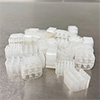| Aug 06, 2025 |
Researchers describe how biofilm-based processes can be used to produce biomethane with over 96 percent purity.
|
|
(Nanowerk News) Carbon-based gases such as carbon dioxide (CO₂) and carbon monoxide (CO) are often associated with pollution and climate change. But what if these gases could be turned into something useful instead – like clean-burning fuel?
|
|
This is what Dr Lu Feng and other researchers have been working on. The goal of the collaboration has been to develop a new method for producing green biomethane, a sustainable alternative to natural gas.
|
|
Through five scientific papers (most recent: Biomass and Bioenergy, “Impact of hydrogen sulphide on biomethanation and the potential mechanisms of mitigation”), the researchers have documented how biofilm-based processes can be used to produce biomethane with over 96 percent purity.
|
 |
| Small plastic pieces from Biowater Technology called biofilm carriers, which are widely used in water and waste treatment systems. These provide a surface where helpful bacteria can grow and carry out their function in an efficient way. (Image: Lu Feng)
|
Engineered biofilm for targeted conversion
|
|
A biofilm is a layer of microorganisms that grow on surfaces. The microbes work together and form a kind of community that can process gases and turn them into methane.
|
|
“Instead of decomposing organic waste, as is done in traditional biogas production, the biofilm method captures and processes gas streams using self-selected microorganisms harbored within thin biofilm under oxygen free conditions,” Dr Feng explains.
|
|
“Biofilms are widespread in nature,” he continues. “Our aim has been to engineer the biofilm to work for us for targeted conversion, either by using fixed or moving bed reactors. This opens new opportunities to convert climate-impacting gases into valuable energy.”
|
|
Among other things, the researchers experimented with adding selected microorganisms – a process known as bioaugmentation – to improve methane production.
|
|
“By introducing specific methane-producing microbes into the reactors, we were able to steer the process towards more efficient CO₂ conversion,” says Dr Feng.
|
Biofilm reactors maintain high methane quality and tolerance
|
|
Dr Feng says that the biofilms they have developed provide a stable and efficient process.
|
|
“They help retain the microbes, improve gas–liquid contact, and largely increase contact surface for the reaction. They also tolerate harmful substances that would otherwise disrupt gas production.”
|
|
In particular, biofilms can help manage challenges such as high levels of ammonia and hydrogen sulphide (H2S). These are substances often found in industrial gas streams and can be problematic in conventional bioreactors.
|
|
“In one of our studies, we tested how biofilm reactors handle H2S which is a toxic gas that can significantly reduce methane production,” says Dr Feng.
|
|
“The results showed that systems without biofilm lost up to 30 percent of the methane, while the biofilm reactors maintained high methane quality even at extremely high H2S content.”
|
|
The researchers also examined the effect of ammonia, which usually inhibits methane production. In this study, they used a type of reactor called AnMBBR (Anaerobic Moving Bed Biofilm Reactor), and found that the biofilms were able to produce methane even at high ammonia concentrations.
|
|
“High ammonia can be accumulated when fish sludge, animal slurry, or food waste are used to produce biogas”, says Dr Feng.
|
|
“Our analysis showed that the biofilm contained microbes that tolerate ammonia, including a group called Methanothermobacter, which can use H₂ and CO₂ to produce methane.”
|
Unlocks great potential from unconventional substrates
|
|
In another study, the researchers tested the biofilm method on syngas – a combination of hydrogen and carbon monoxide.
|
|
“This could unlock the potential of using waste to produce biomethane, for example plastic waste and woody biomass, which under normal circumstances does not degrade in a bioprocess,” Dr Feng says.
|
|
The researchers found that adding extra hydrogen could increase methane production.
|
|
Too much hydrogen, however, led to imbalance in the process.
|
|
“This shows that biofilm reactors have great potential, but also that they require careful control to function optimally at industrial scale,” says Dr Feng.
|
|
“Biofilm-based processes offer a robust and flexible platform for future biogas production. This could become an important contribution to reducing harmful gas emissions while producing renewable energy,” he adds.
|
Full bibliographic information
|
|
Getachew Birhanu Abera, Thea Os Andersen, Linn Solli, Svein Jarle Horn, Lu Feng, Impact of hydrogen sulphide on biomethanation and the potential mechanisms of mitigation, Biomass and Bioenergy, Volume 201, 2025,108051, ISSN 0961-9534, https://doi.org/10.1016/j.biombioe.2025.108051
|
|
Getachew Birhanu Abera, Aryan Bhusal, Thea Os Andersen, Shuai Wang, Nabin Aryal, Svein Jarle Horn, Lu Feng, Mitigating ammonia inhibition in in-situ biomethanation using anaerobic moving bed biofilm reactor, Journal of Environmental Chemical Engineering, Volume 13, Issue 5, 2025,118355, ISSN 2213-3437, https://doi.org/10.1016/j.jece.2025.118355
|
|
Begüm Bilgiç, Thea Os Andersen, Getachew Birhanu Abera, Michal Sposób, Lu Feng, Svein Jarle Horn, Syngas biomethanation using trickle bed reactor, impact of external hydrogen addition at high loading rate, Bioresource Technology Reports, Volume 31, 2025,102197, ISSN 2589-014X, https://doi.org/10.1016/j.biteb.2025.102197
|
|
Lu Feng, Thea Os Andersen, Live Heldal Hagen, Begum Bilgic, Svein Jarle Horn, Bioaugmentation by enriched hydrogenotrophic methanogens into trickle bed reactors for H2/CO2 conversion, Bioresource Technology, Volume 408, 2024, 131225, ISSN 0960-8524, https://doi.org/10.1016/j.biortech.2024.131225
|
|
Abera, G.B., Trømborg, E., Solli, L. et al. Biofilm application for anaerobic digestion: a systematic review and an industrial scale case. Biotechnol Biofuels 17, 145 (2024). https://doi.org/10.1186/s13068-024-02592-4
|


